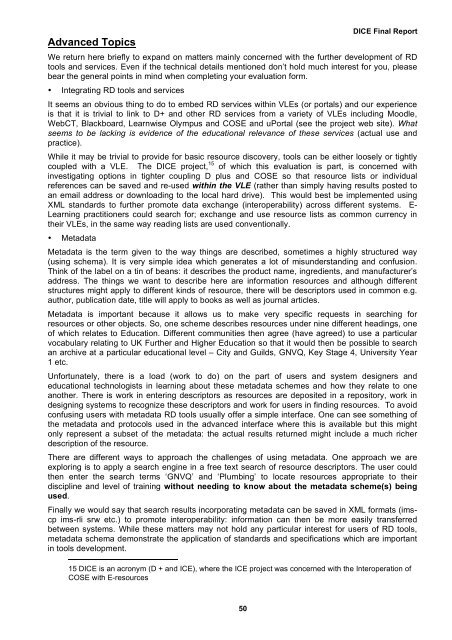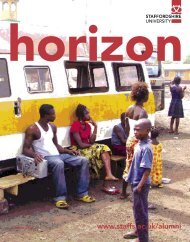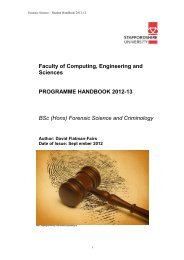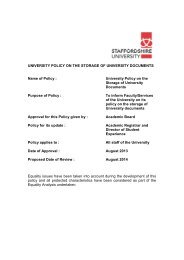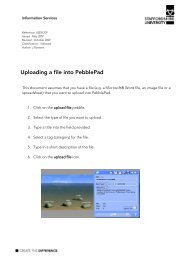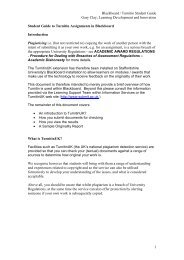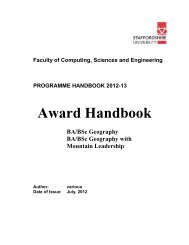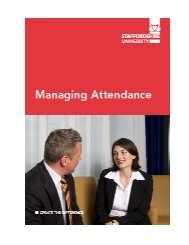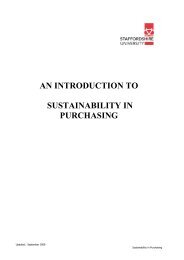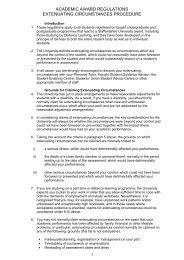DICE Project Final Report Resource Discovery Tools Evaluation and ...
DICE Project Final Report Resource Discovery Tools Evaluation and ...
DICE Project Final Report Resource Discovery Tools Evaluation and ...
Create successful ePaper yourself
Turn your PDF publications into a flip-book with our unique Google optimized e-Paper software.
Advanced Topics<br />
<strong>DICE</strong> <strong>Final</strong> <strong>Report</strong><br />
We return here briefly to exp<strong>and</strong> on matters mainly concerned with the further development of RD<br />
tools <strong>and</strong> services. Even if the technical details mentioned don’t hold much interest for you, please<br />
bear the general points in mind when completing your evaluation form.<br />
• Integrating RD tools <strong>and</strong> services<br />
It seems an obvious thing to do to embed RD services within VLEs (or portals) <strong>and</strong> our experience<br />
is that it is trivial to link to D+ <strong>and</strong> other RD services from a variety of VLEs including Moodle,<br />
WebCT, Blackboard, Learnwise Olympus <strong>and</strong> COSE <strong>and</strong> uPortal (see the project web site). What<br />
seems to be lacking is evidence of the educational relevance of these services (actual use <strong>and</strong><br />
practice).<br />
While it may be trivial to provide for basic resource discovery, tools can be either loosely or tightly<br />
coupled with a VLE. The <strong>DICE</strong> project, 15 of which this evaluation is part, is concerned with<br />
investigating options in tighter coupling D plus <strong>and</strong> COSE so that resource lists or individual<br />
references can be saved <strong>and</strong> re-used within the VLE (rather than simply having results posted to<br />
an email address or downloading to the local hard drive). This would best be implemented using<br />
XML st<strong>and</strong>ards to further promote data exchange (interoperability) across different systems. E-<br />
Learning practitioners could search for; exchange <strong>and</strong> use resource lists as common currency in<br />
their VLEs, in the same way reading lists are used conventionally.<br />
• Metadata<br />
Metadata is the term given to the way things are described, sometimes a highly structured way<br />
(using schema). It is very simple idea which generates a lot of misunderst<strong>and</strong>ing <strong>and</strong> confusion.<br />
Think of the label on a tin of beans: it describes the product name, ingredients, <strong>and</strong> manufacturer’s<br />
address. The things we want to describe here are information resources <strong>and</strong> although different<br />
structures might apply to different kinds of resource, there will be descriptors used in common e.g.<br />
author, publication date, title will apply to books as well as journal articles.<br />
Metadata is important because it allows us to make very specific requests in searching for<br />
resources or other objects. So, one scheme describes resources under nine different headings, one<br />
of which relates to Education. Different communities then agree (have agreed) to use a particular<br />
vocabulary relating to UK Further <strong>and</strong> Higher Education so that it would then be possible to search<br />
an archive at a particular educational level – City <strong>and</strong> Guilds, GNVQ, Key Stage 4, University Year<br />
1 etc.<br />
Unfortunately, there is a load (work to do) on the part of users <strong>and</strong> system designers <strong>and</strong><br />
educational technologists in learning about these metadata schemes <strong>and</strong> how they relate to one<br />
another. There is work in entering descriptors as resources are deposited in a repository, work in<br />
designing systems to recognize these descriptors <strong>and</strong> work for users in finding resources. To avoid<br />
confusing users with metadata RD tools usually offer a simple interface. One can see something of<br />
the metadata <strong>and</strong> protocols used in the advanced interface where this is available but this might<br />
only represent a subset of the metadata: the actual results returned might include a much richer<br />
description of the resource.<br />
There are different ways to approach the challenges of using metadata. One approach we are<br />
exploring is to apply a search engine in a free text search of resource descriptors. The user could<br />
then enter the search terms ‘GNVQ’ <strong>and</strong> ‘Plumbing’ to locate resources appropriate to their<br />
discipline <strong>and</strong> level of training without needing to know about the metadata scheme(s) being<br />
used.<br />
<strong>Final</strong>ly we would say that search results incorporating metadata can be saved in XML formats (imscp<br />
ims-rli srw etc.) to promote interoperability: information can then be more easily transferred<br />
between systems. While these matters may not hold any particular interest for users of RD tools,<br />
metadata schema demonstrate the application of st<strong>and</strong>ards <strong>and</strong> specifications which are important<br />
in tools development.<br />
15 <strong>DICE</strong> is an acronym (D + <strong>and</strong> ICE), where the ICE project was concerned with the Interoperation of<br />
COSE with E-resources<br />
50


